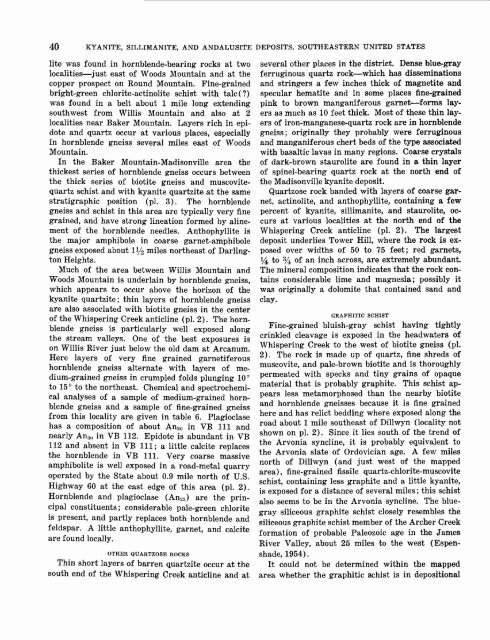Kyanite, Sillimanite, and Andalusite Deposits of the Southeastern ...
Kyanite, Sillimanite, and Andalusite Deposits of the Southeastern ...
Kyanite, Sillimanite, and Andalusite Deposits of the Southeastern ...
You also want an ePaper? Increase the reach of your titles
YUMPU automatically turns print PDFs into web optimized ePapers that Google loves.
40 KYANITE, SILLIMANITE, AND ANDALUSITE DEPOSITS, SOUTHEASTERN UNITED STATES<br />
lite was found in hornblende-bearing rocks at two<br />
localities just east <strong>of</strong> Woods Mountain <strong>and</strong> at <strong>the</strong><br />
copper prospect on Round Mountain. Fine-grained<br />
bright-green chlorite-actinolite schist with talc(?)<br />
was found in a belt about 1 mile long extending<br />
southwest from Willis Mountain <strong>and</strong> also at 2<br />
localities near Baker Mountain. Layers rich in epidote<br />
<strong>and</strong> quartz occur at various places, especially<br />
in hornblende gneiss several miles east <strong>of</strong> Woods<br />
Mountain.<br />
In <strong>the</strong> Baker Mountain-Madisonville area <strong>the</strong><br />
thickest series <strong>of</strong> hornblende gneiss occurs between<br />
<strong>the</strong> thick series <strong>of</strong> biotite gneiss <strong>and</strong> muscovitequartz<br />
schist <strong>and</strong> with kyanite quartzite at <strong>the</strong> same<br />
stratigraphic position (pi. 3). The hornblende<br />
gneiss <strong>and</strong> schist in this area are typically very fine<br />
grained, <strong>and</strong> have strong lineation formed by alinement<br />
<strong>of</strong> <strong>the</strong> hornblende needles. Anthophyllite is<br />
<strong>the</strong> major amphibole in coarse garnet-amphibole<br />
gneiss exposed about iy% miles nor<strong>the</strong>ast <strong>of</strong> Darlington<br />
Heights.<br />
Much <strong>of</strong> <strong>the</strong> area between Willis Mountain <strong>and</strong><br />
Woods Mountain is underlain by hornblende gneiss,<br />
which appears to occur above <strong>the</strong> horizon <strong>of</strong> <strong>the</strong><br />
kyanite quartzite; thin layers <strong>of</strong> hornblende gneiss<br />
are also associated with biotite gneiss in <strong>the</strong> center<br />
<strong>of</strong> <strong>the</strong> Whispering Creek anticline (pi. 2). The hornblende<br />
gneiss is particularly well exposed along<br />
<strong>the</strong> stream valleys. One <strong>of</strong> <strong>the</strong> best exposures is<br />
on Willis River just below <strong>the</strong> old dam at Arcanum.<br />
Here layers <strong>of</strong> very fine grained garnetiferous<br />
hornblende gneiss alternate with layers <strong>of</strong> medium-grained<br />
gneiss in crumpled folds plunging 10°<br />
to 15° to <strong>the</strong> nor<strong>the</strong>ast. Chemical <strong>and</strong> spectrochemical<br />
analyses <strong>of</strong> a sample <strong>of</strong> medium-grained hornblende<br />
gneiss <strong>and</strong> a sample <strong>of</strong> fine-grained gneiss<br />
from this locality are given in table 6. Plagioclase<br />
has a composition <strong>of</strong> about An20 in VB 111 <strong>and</strong><br />
nearly An30 in VB 112. Epidote is abundant in VB<br />
112 <strong>and</strong> absent in VB 111; a little calcite replaces<br />
<strong>the</strong> hornblende in VB 111. Very coarse massive<br />
amphibolite is well exposed in a road-metal quarry<br />
operated by <strong>the</strong> State about 0.9 mile north <strong>of</strong> U.S.<br />
Highway 60 at <strong>the</strong> east edge <strong>of</strong> this area (pi. 2).<br />
Hornblende <strong>and</strong> plagioclase (An25 ) are <strong>the</strong> principal<br />
constituents; considerable pale-green chlorite<br />
is present, <strong>and</strong> partly replaces both hornblende <strong>and</strong><br />
feldspar. A little anthophyllite, garnet, <strong>and</strong> calcite<br />
are found locally.<br />
OTHER QUARTZOSE ROCKS<br />
Thin short layers <strong>of</strong> barren quartzite occur at <strong>the</strong><br />
south end <strong>of</strong> <strong>the</strong> Whispering Creek anticline <strong>and</strong> at<br />
several o<strong>the</strong>r places in <strong>the</strong> district. Dense blue-gray<br />
ferruginous quartz rock which has disseminations<br />
<strong>and</strong> stringers a few inches thick <strong>of</strong> magnetite <strong>and</strong><br />
specular hematite <strong>and</strong> in some places fine-grained<br />
pink to brown manganiferous garnet forms layers<br />
as much as 10 feet thick. Most <strong>of</strong> <strong>the</strong>se thin layers<br />
<strong>of</strong> iron-manganese-quartz rock are in hornblende<br />
gneiss; originally <strong>the</strong>y probably were ferruginous<br />
<strong>and</strong> manganiferous chert beds <strong>of</strong> <strong>the</strong> type associated<br />
with basaltic lavas in many regions. Coarse crystals<br />
<strong>of</strong> dark-brown staurolite are found in a thin layer<br />
<strong>of</strong> spinel-bearing quartz rock at <strong>the</strong> north end <strong>of</strong><br />
<strong>the</strong> Madisonville kyanite deposit.<br />
Quartzose rock b<strong>and</strong>ed with layers <strong>of</strong> coarse garnet,<br />
actinolite, <strong>and</strong> anthophyllite, containing a few<br />
percent <strong>of</strong> kyanite, sillimanite, <strong>and</strong> staurolite, occurs<br />
at various localities at <strong>the</strong> north end <strong>of</strong> <strong>the</strong><br />
Whispering Creek anticline (pi. 2). The largest<br />
deposit underlies Tower Hill, where <strong>the</strong> rock is exposed<br />
over widths <strong>of</strong> 50 to 75 feet; red garnets,<br />
1A t° % <strong>of</strong> an inch across, are extremely abundant.<br />
The mineral composition indicates that <strong>the</strong> rock contains<br />
considerable lime <strong>and</strong> magnesia; possibly it<br />
was originally a dolomite that contained s<strong>and</strong> <strong>and</strong><br />
clay.<br />
GRAPHITIC SCHIST<br />
Fine-grained bluish-gray schist having tightly<br />
crinkled cleavage is exposed in <strong>the</strong> headwaters <strong>of</strong><br />
Whispering Creek to <strong>the</strong> west <strong>of</strong> biotite gneiss (pi.<br />
2). The rock is made up <strong>of</strong> quartz, fine shreds <strong>of</strong><br />
muscovite, <strong>and</strong> pale-brown biotite <strong>and</strong> is thoroughly<br />
permeated with specks <strong>and</strong> tiny grains <strong>of</strong> opaque<br />
material that is probably graphite. This schist appears<br />
less metamorphosed than <strong>the</strong> nearby biotite<br />
<strong>and</strong> hornblende gneisses because it is fine grained<br />
here <strong>and</strong> has relict bedding where exposed along <strong>the</strong><br />
road about 1 mile sou<strong>the</strong>ast <strong>of</strong> Dillwyn (locality not<br />
shown on pi. 2). Since it lies south <strong>of</strong> <strong>the</strong> trend <strong>of</strong><br />
<strong>the</strong> Arvonia syncline, it is probably equivalent to<br />
<strong>the</strong> Arvonia slate <strong>of</strong> Ordovician age. A few miles<br />
north <strong>of</strong> Dillwyn (<strong>and</strong> just west <strong>of</strong> <strong>the</strong> mapped<br />
area), fine-grained fissile quartz-chlorite-muscovite<br />
schist, containing less graphite <strong>and</strong> a little kyanite,<br />
is exposed for a distance <strong>of</strong> several miles; this schist<br />
also seems to be in <strong>the</strong> Arvonia syncline. The bluegray<br />
siliceous graphite schist closely resembles <strong>the</strong><br />
siliceous graphite schist member <strong>of</strong> <strong>the</strong> Archer Creek<br />
formation <strong>of</strong> probable Paleozoic age in <strong>the</strong> James<br />
River Valley, about 25 miles to <strong>the</strong> west (Espenshade,<br />
1954).<br />
It could not be determined within <strong>the</strong> mapped<br />
area whe<strong>the</strong>r <strong>the</strong> graphitic schist is in depositional
















